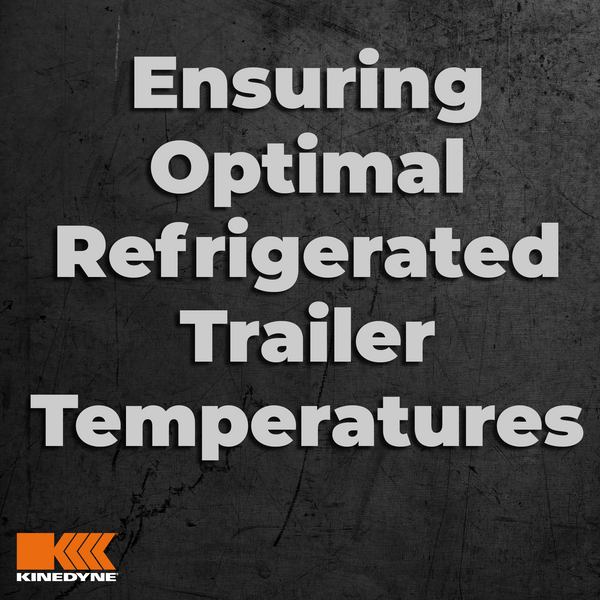Managing Refrigerated Trailer Temperatures
Refrigerated trailers play a crucial role in the transportation and storage of perishable goods, ensuring that they remain fresh and safe for consumption. Maintaining the appropriate temperature within these trailers is of paramount importance to prevent spoilage and preserve the quality of the contents. In this blog, we will explore effective strategies to keep your refrigerated trailer temperatures cold and delve into why it is vital to maintain low temperatures for the items inside.Why is it Important to Keep the Contents of the Trailer at Low Temperatures?
Preservation of Freshness
Preserving the freshness of perishable goods is the primary objective of refrigerated transportation. Lowering the temperature within the trailer helps slow down the growth of bacteria, mold, and other microorganisms that cause spoilage. This is particularly crucial for food products, as it ensures that they reach their destination in optimum condition, maintaining their taste, texture, and nutritional value.
Food Safety
Maintaining low temperatures within refrigerated trailers is a fundamental aspect of food safety. Cold temperatures inhibit the growth of pathogens, reducing the risk of foodborne illnesses. Temperature-sensitive foods such as meat, dairy products, and seafood are especially vulnerable to bacterial contamination. By adhering to proper temperature guidelines, you can significantly reduce the chances of foodborne diseases, ensuring the well-being of consumers.
Extended Shelf Life
Controlling the temperature in refrigerated trailers extends the shelf life of perishable goods. Cold environments slow down the chemical and enzymatic reactions responsible for food degradation, thereby prolonging the product's freshness. By keeping temperatures consistently low, you can increase the viability of perishable items, reducing waste and maximizing profitability.
Strategies to Keep Refrigerated Trailer Temperatures Cold
Pre-cooling
Before loading any perishable goods into the trailer, pre-cool it to the desired temperature. This process ensures that the internal temperature of the trailer is stable and ready to accommodate the products. Pre-cooling involves running the refrigeration system in advance, allowing it to reach the desired temperature range before loading begins.
Proper Loading Practices
Efficient loading practices are essential for maintaining cold temperatures within the trailer. Ensure that goods are stacked in a manner that promotes adequate airflow throughout the trailer. Leave space between the pallets or cartons to allow for proper air circulation, preventing hotspots and ensuring consistent cooling. For the drivers who load the trailer, it is key to load the cargo quickly and efficiently.
The Kinedyne Kold-Front comes with a unique patented roller that has 5 touchpoints making the sliding of the curtain speedy and smooth. A traditional roller only has 2 touchpoints and wears down quicker causing frustration every time you have to open the curtain when loading and unloading the goods.
Temperature Monitoring
Utilize advanced temperature monitoring systems to track and maintain the desired temperature range inside the trailer. These systems provide real-time temperature readings and alerts, allowing you to identify and address any deviations promptly. Regularly calibrate and maintain temperature monitoring equipment to ensure accurate readings.
The Kinedyne Kold-Front Curtain is 40% heavier than traditional strip curtains so the trailer’s temperature will stay cooler longer.
Insulation and Sealing
Inspect the trailer's insulation and seals regularly to ensure they are intact and functioning effectively. Any gaps or leaks can lead to temperature fluctuations, reducing the efficiency of the cooling system. Pay particular attention to the door seals, roof, and walls of the trailer.
The Kinedyne Kold-Front Kit ensures insulation with a heavy-duty curtain, while easy opening and closing with the gliding of the roller along the track. Proper insulation and sealing prevents the access of warm air and maintains a consistent cold environment.
Routine Maintenance
Regularly service and maintain the refrigeration unit to optimize its performance. Schedule routine inspections to check for refrigerant leaks, clean the condenser coils, and replace air filters. Proper maintenance helps the refrigeration system run efficiently, reducing energy consumption and maintaining the desired temperature range consistently.
Keeping refrigerated trailer temperatures cold is imperative for preserving the freshness, safety, and quality of perishable goods during transportation and storage. By understanding the significance of maintaining low temperatures and implementing effective strategies such as pre-cooling, proper loading practices, temperature monitoring, insulation, and routine maintenance, you can ensure that your goods reach their destination in optimal condition. Prioritizing temperature control not only reduces waste but also safeguards the health and satisfaction of consumers, enhancing your business reputation in the process.
 US Dollars
US Dollars


 US EN
US EN
 MX ES
MX ES
